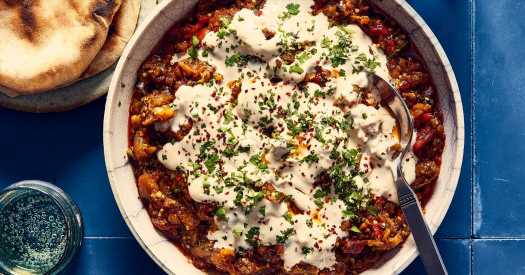I was flipping through Niki Segnit’s new book, “The Flavor Thesaurus: More Flavors,” as I was making this recipe.
Recipe: Zaalouk With Tahini
Doing these two things together — not quite literally — sent me in two seemingly opposite directions. In one (the one in which I was holding the book), I was sent down a rabbit hole of potential. In the other (the one in which I was holding a wooden spoon), I was taken to a place of familiarity and ease. It felt paradoxical but made sense.
First: the hand with the wooden spoon. While gathering the ingredients to make my zaalouk — a Moroccan salad or dip that’s so perfect for this time of the year, when vegetables are begging to be charred and eaten outside, with friends and bread — I had a deep sense of comfort. I was in familiar territory. Peppers and eggplants, tomatoes and tomato paste, my happy place. Olive oil, tahini, lemon juice and garlic, my home. Spices from the spice rack: cumin, paprika, chile flakes. Herbs freshly gathered: parsley and cilantro.
As I set about charring my eggplants and peppers, I considered all the directions I could take with this set of ingredients: a roasted vegetable soup or a deeply flavored pasta sauce, blitzed or chunky, each with its own result. Spooned on rice, it could be a stew. Cooked in a pan with some eggs, it would be shakshuka, my favorite breakfast. Keeping the tomatoes raw, I could make a sandwich in a pita, adding roasted eggplant, some tahini and parsley sauce.
Warm dips, hot soups, cold salsas, thick sauces, chopped salads: The ingredients’ potential gave me a sort of unthinking ease that I don’t always have when trying out new recipes. We talk about comfort food and comfort eating, but it is in such instances, when you know your ingredients so well and they know one another, that it also makes sense to talk about comfort cooking.
To me, this kind of cooking feels like standing on a firm foundation. It means you can freestyle and play around. Herbs you have on hand can be substituted (dill and basil here, instead of parsley and cilantro); spices can be added or substituted (caraway and cardamom are good candidates here). To top it off, it’s a case of opening the fridge and seeing what’s there: buttermilk and feta dressing, perhaps, instead of tahini, or maybe harissa, pine nuts and eggs, to be poached or fried.
That was the hand with the wooden spoon. The other hand was skipping frantically along Segnit’s “flavor wheel,” the clever device at the heart of this book and its predecessor, “The Flavor Thesaurus.” Choose an ingredient — eggplant! Spin the wheel, and Segnit will remind you of pairings you know work well. (Eggplants “dream of sheep,” she writes. “Their favorite meat is lamb, their chosen yogurt sheep’s.”) She also tells you why they work.
After all the combinations you think you know, the ones you’ve never even considered will blow your mind. Say, eggplant and chocolate, in the southern Italian melanzane al cioccolato: fried eggplant strips, breaded and pressed together and covered with a glossy chocolate sauce, scattered with candied citrus and toasted pine nuts. I mean. …
Add 90 or so more flavors, spin the wheel again and, before long, you’ll find yourself with about 16 pages earmarked and 15 new ideas hatched. Eggplants take you to chocolate, which takes you to miso, which takes you to seaweed, which takes you to a recipe in another book or a restaurant dish you have to hunt down straight away. The curiosity is infectious, the possibilities inspiring on this ingredient-led voyage.
I thought of all this and considered that it might be the way books about food are heading: where the interest is more in ideas and suggestions than in a fixed list of ingredients and necessary steps. I agreed absolutely with that thought, as I came up with this recipe, which I loved so much that I just had to write it down and fix it, with instructions, ready to share.
But remember the paradox: Comfort is offered up by the firm ground of the familiar — well-known ingredients — while the rabbit hole is just there, below your feet, ready for you to fall down and explore.
Recipe: Zaalouk With Tahini
Yotam Ottolenghi is a writer and the chef-owner of the Ottolenghi restaurants, Nopi and Rovi, in London. He is an Eat columnist for The New York Times Magazine and writes a weekly column for The Guardian’s Feast Magazine. @ottolenghi
Source: Read Full Article
